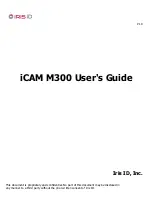
l
Counting the increase at each rising and falling edge of both channels when channel A
leads channel B. Counting the decrease at each rising and falling edge of both channels
when channel B leads channel A.
For
more
information,
see
169).
6.6.6
Pulse
measurement
tips
The
PulseCount()
instruction
uses
dedicated
32-bit
counters
to
accumulate
all
counts
over
the
programmed
scan
interval.
The
resolution
of
pulse
counters
is
one
count
or
1
Hz.
Counters
are
read
at
the
beginning
of
each
scan
and
then
cleared.
Counters
will
overflow
if
accumulated
counts
exceed
4,294,967,296
(2
32
),
resulting
in
erroneous
measurements.
Counts
are
the
preferred
PulseCount()
output
option
when
measuring
the
number
of
tips
from
a
tipping-bucket
rain
ga
u
ge
or
the
number
of
times
a
door
opens.
Many
pulse-output
sensors,
such
as
anemometers
and
flow
meters,
are
calibrated
in
terms
of
frequency
(Hz)
so
are
usually
measured
using
the
PulseCount()
frequency-output
option.
Use
the
LLAC4
module
to
convert
non-TTL-level
signals,
including
low-level
ac
signals,
to
TTL
levels
for
input
to
C
terminals
Conflicts
can
occur
when
a
control
port
pair
is
used
for
different
instructions
(
TimerInput()
,
PulseCount()
,
SDI12Recorder()
,
WaitDigTrig()
).
For
example,
if
C1
is
used
for
SDI12Recorder()
,
C2
cannot
be
used
for
TimerInput()
,
PulseCount
()
,
or
WaitDigTrig()
.
Understanding
the
signal
to
be
measured
and
compatible
input
terminals
and
CRBasic
instructions
is
helpful.
See
72).
6.6.6.1
Input
filters
and
signal
attenuation
Terminals
configured
for
pulse
input
have
internal
filters
that
reduce
electronic
noise.
The
electronic
noise
can
result
in
false
counts.
However,
input
filters
attenuate
(reduce)
the
amplitude
(voltage)
of
the
signal.
Attenuation
is
a
function
of
the
frequency
of
the
signal.
Higher-frequency
signals
are
attenuated
more.
If
a
signal
is
attenuated
too
much,
it
may
not
pass
the
detection
thresholds
required
by
the
pulse
count
circuitry.
See
for
more
information.
The
listed
pulse
measurement
specifications
account
for
attenuation
due
to
input
filtering.
6.6.6.2
Pulse
count
resolution
Longer
scan
intervals
result
in
better
resolution.
PulseCount()
resolution
is
1
pulse
per
scan.
On
a
1
second
scan,
the
resolution
is
1
pulse
per
second.
The
resolution
on
a
10
second
scan
6. Measurements
77
Содержание CR1000X
Страница 1: ...Revision 02 21 2019 Copyright 2000 2019 Campbell Scientific ...
Страница 2: ......
Страница 4: ......
Страница 6: ......
Страница 8: ......
Страница 16: ...Appendix A Glossary 176 Appendix B Index 214 Table of Contents viii ...
Страница 20: ...l Smart sensors o SDI 12 o RS 232 o Modbus o DNP3 o TCP IP o RS 485 1 Data acquisition system components 4 ...
Страница 192: ......
Страница 237: ...wiring panel 5 Appendix B Index 220 ...
















































